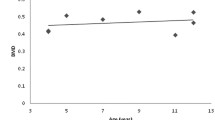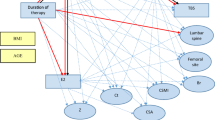Abstract:
Klinefelter’s syndrome (KS) is a common sex chromosomal disorder associated with androgen deficiency and osteoporosis. Only few bone mineral density (BMD) and no quantitative ultrasound (QUS) data are available in these patients after long-term testosterone replacement therapy. We examined in a cross-sectional study 52 chromatin-positive KS patients aged 39.1 ± 12.4 years (mean ± SD). Patients had been treated with oral or parenteral androgens for 9.2 ± 8.2 years (range 1–32 years). Areal BMD and bone mineral apparent density (BMAD, i.e., estimated volumetric BMD) at the lumbar spine, total hip and femoral neck were determined by dual-energy X-ray absorptiometry. BMD T-scores in the patient group were calculated based on three different North American reference databases. The QUS parameters broadband ultrasound attenuation (BUA) and speed of sound (SOS) were measured at the calcaneus using an ultrasound imaging device (UBIS 3000) and were compared with QUS results in a sex-, age- and height-matched control group. QUS T-scores were calculated based on the results of QUS measurements in 50 normal Dutch men between the ages of 20 and 30 years. QUS and BMD results in the KS patient group were compared. Overall, based on the three reference databases, 46% and 63% of the KS patients had a T-score between −1 and −2.5 and a further 10% and 14% had a T-score ≤−2.5 at the total hip and/or lumbar spine, as measured by areal BMD or BMAD, respectively. Thirty-nine percent of the KS patients had a T-score between −2.5 and −1, while 2% had a T-score ≤−2.5 for BUA and/or SOS. BUA (77.7 ± 15.0 dB/MHz) and SOS (1518.8 ± 36.5 m/s) were significantly lower in the KS patients than in age- and height-matched controls (87.1 ± 17.8 dB/MHz, p<0.005, and 1536.5 ± 42.5 m/s, p<0.05). Correlation coefficients between the QUS parameters and areal BMD (0.28 to 0.37) or BMAD (0.27 to 0.46) were modest. ROC analysis showed that discrimination of a BMD or BMAD T-score ≤−2.5 with either BUA or SOS was not statistically significant.
Although a limitation of our study is that direct comparison of BMD and QUS T-scores is not possible because in the control group in which QUS parameters were determined no BMD measurements were performed, we conclude that despite long-term testosterone replacement therapy, a considerable percentage of patients with KS had a BMD T-score <−1 or even ≤−2.5, based on different North American reference databases. This percentage was even higher for BMAD. QUS parameters were also low in the KS patient group when compared with Dutch control subjects. QUS parameters cannot be used to predict BMD or BMAD in KS patients.
Similar content being viewed by others
Author information
Authors and Affiliations
Additional information
Received: 28 February 2000 / Accepted: 3 August 2000
Rights and permissions
About this article
Cite this article
van den Bergh, J., Hermus, A., Spruyt, A. et al. Bone Mineral Density and Quantitative Ultrasound Parameters in Patients with Klinefelter’s Syndrome after Long-Term Testosterone Substitution . Osteoporos Int 12, 55–62 (2001). https://doi.org/10.1007/s001980170158
Issue Date:
DOI: https://doi.org/10.1007/s001980170158




